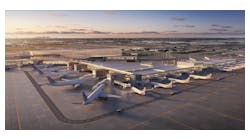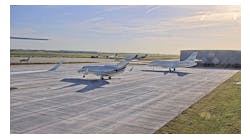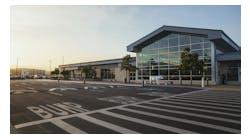Oregon’s Portland International Airport ranked highest in satisfaction among large airports for the second consecutive year, with a score of 786, on the J.D. Power 2016 North America Airport Satisfaction Study, released Dec. 15. Tampa International Airport (775) ranked second, followed by and Las Vegas McCarran Airport (759).
Indianapolis International Airport topped the list among medium-sized airports, with a score of 794. Buffalo Niagara International Airport (791) ranked second, while and Fort Myers/Southwest Florida International Airport (790) ranked third.
Now in its 11th year, the study measures overall traveler satisfaction by looking at six factors: terminal facilities; airport accessibility; security check; baggage claim; check-in/baggage check; and food, beverage and retail.
Looking at the biggest and busiest U.S. airports, the study noted that LaGuardia Airport is in the middle of a multibillion dollar redesign, where construction woes contributed to a six-point drop in overall satisfaction for the airport in 2016. “This improvement has been needed for a long time. The new design is going to create major short- term headaches for LaGuardia travelers, but the results will be worth it,” said said Michael Taylor, director of the airport practice at J.D. Power. “The design solves two major problems for the airport: overcrowding and the ability to move aircraft more efficiently on and off runways.”
Chicago O’Hare International Airport saw its satisfaction score rise 9 points, thanks to a year almost free of major weather events that helped operations and on-time performance. “The primary reason to take an airplane flight is not to enjoy a movie or to eat a meal; the principal objective is to get somewhere on time,” said Taylor. “The weather has cooperated for much of the year, and that has made traveling through O’Hare much easier.”
Los Angeles International Airport completed a major redesign of Terminal 2, which was completed in February 2016. “Terminal 2’s new design and the amenities it now offers are partly responsible for a hefty 32-point jump in overall satisfaction,” said Taylor. “Terminal 2 represents the wave of new airport designs with a mix of local and chain restaurants and a more open feel to the terminal. While that’s a good thing, there is much more construction scheduled at Los Angeles for the next several years, and the airport’s U-shaped layout will make access an issue during renovations.”
Hartsfield-Jackson Atlanta International -- the world’s busiest airport -- will have handled more than 100 million passengers by the end of 2016. “If you think about it, that’s putting about one-third of the U.S. population through a few buildings in Georgia over the course of a year,” said Taylor. “Yet, everything runs fairly efficiently.” But the airport is feeling the strain, with satisfaction down nine points in 2016. The airport does have $6 billion worth of redesigns planned over the next 20 years.
Las Vegas McCarran International Airport continues to set traveler volume records month after month. The airport has deployed the latest technologies to maintain a fluid traveler flow through the airport, with self-service passport control kiosks in place since 2014.
“That has really helped smooth things out for international travelers,” said Taylor. “McCarran has plans to double its number of international gates and take on larger aircraft. It’s going to need these improvements to handle those loads, but they’re definitely thinking ahead.”
Dallas/Fort Worth International Airport saw its satisfaction number in food/beverage rise 15 points after opening new, innovative restaurants. c“Food outlets such as Lorena Garcia’s TAPAS y Cocina are an excellent example of airports offering travelers something unique to their location,” said Taylor. “Texas and Latin food naturally go together. It’s a good illustration of an airport creating that ‘sense of place’ that really helps traveler satisfaction.”
Even with an increased number of travelers moving through airports—many of which are not designed for the volume of people and flights they now support—overall satisfaction with their airport experience is improving, according to the study.
Overall traveler satisfaction with the airport experience averages 731 (on a 1,000-point scale) in 2016, an improvement from 725 in 2015. Overall satisfaction with large airports (based on FAA classifications) is 724, a 5-point increase from 2015, and satisfaction with medium airports is 760, an 8-point rise. The increase in satisfaction comes at a time when airports are posting a 5-6 percent annual increase in traveler volumes.
“Many airports, especially the nation’s largest airports, were never built to handle the current volume of traveler traffic, often exceeding their design limits by many millions of travelers,” said Taylor. “Yet airports are overcoming infrastructure limits by affecting the things they can influence. Airports are successfully applying technology to improve check-in (+5 points year-over-year), security screening (+3 points) and the food, beverage and retail shopping (+10 points) experiences.”
Satisfaction improved in each factor of the airport experience, with the greatest year-over-year increases in baggage claim (+11 points) and the food, beverage and retail categories (+10).






